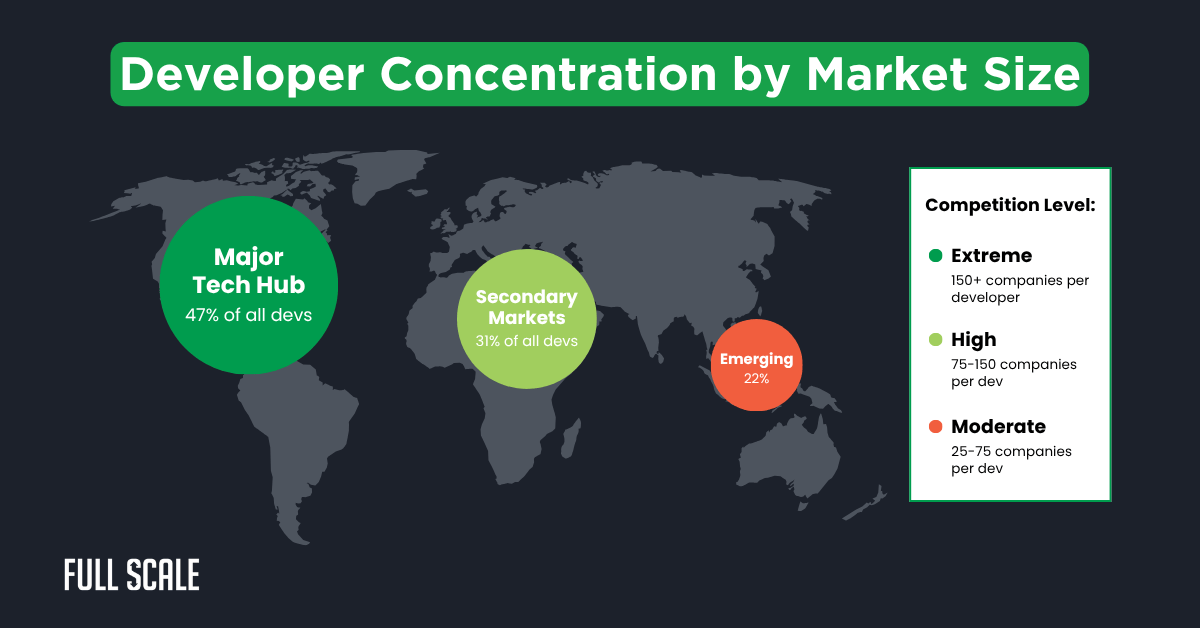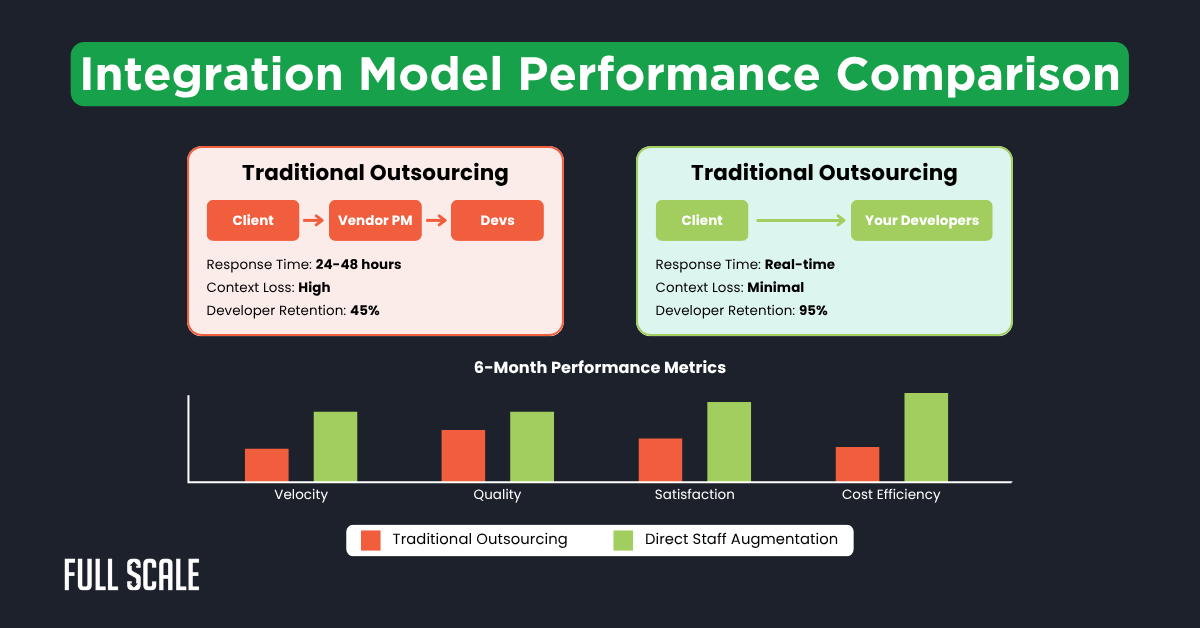Last Updated on 2025-08-26
Did you know that 67% of the 156 tech companies we analyzed will fail to hit their 2025 product roadmaps? The reason? They can’t hire developers fast enough.
Your open positions have been unfilled for months. You’ve lost three candidates to Google this quarter. Your local talent pool is completely exhausted.
Here’s what our hiring data reveals about the developer shortage 2025 solutions that actually work.
The Real Numbers Behind the 2025 Developer Shortage
The tech talent shortage 2025 isn’t just perception—it’s a measurable reality. Our analysis of 156 companies reveals patterns that explain why traditional developer hiring strategies are failing.
Developer Shortage Statistics Dashboard
2025 Developer Shortage: Key Statistics
85%
Companies with positions open 90+ days
Up from 42% in 2020
4.5 months
Average time to hire senior developers
Nearly doubled from 2.3 months in 2020
23%
Year-over-year salary inflation
Senior developer compensation growth
72%
Employed developers open to new opportunities
Creating massive competition for talent
These developer shortage statistics paint a clear picture. The software developer shortage isn’t temporary—it’s structural.
According to the U.S. Bureau of Labor Statistics, software developer employment will grow 25% from 2022 to 2032. That’s much faster than the average for all occupations.
Geographic Concentration Creates Local Scarcity
The developer hiring crisis hits harder in secondary tech markets. When we analyzed developer shortage data by city, patterns emerged.
Developer Distribution Map

Your 50-mile radius has limited qualified developers. Major tech companies are actively recruiting all of them.
Why Traditional Developer Hiring Solutions Don’t Work
Companies stuck in the developer hiring crisis keep trying the same failing approaches. Let’s examine why these traditional methods can’t solve modern problems.
The Recruiter Trap Costs More Than Money
Technical recruiters charge 25% placement fees for developers. That’s $37,500 for a $150,000 developer who might leave in six months.
But the real cost goes beyond fees. Recruiters prioritize placement over retention because that’s how they get paid.
| Traditional Recruiter Model | Hidden Costs |
| 25% placement fee | Lost productivity during 6-month ramp |
| 2-3 month search time | Team morale impact from turnover |
| Limited candidate pool | Repeated recruiting costs |
| No retention guarantees | Knowledge loss when developers leave |
The Freelancer Fantasy Falls Apart
Freelance developers seem like a flexible solution. Project-based work promises to fill gaps without long-term commitment.
Reality tells a different story. When freelancers finish projects, your institutional knowledge walks out the door.
True Cost of Developer Hiring Calculator
True Cost of Traditional Developer Hiring
This calculator reveals why traditional hiring breaks budgets. The true cost extends far beyond salaries and placement fees.
The "Hire Local Only" Myth Limits Your Options
Many companies insist on hiring within driving distance of their office. This made sense when everyone worked on-site daily.
Today's reality? Remote-first companies are fishing in your local pond with unlimited budgets.
CompTIA reports that 67% of tech companies now hire fully remote developers. They're not limited by geography—but you are.
Failed Offshore Attempts Haunt Decision-Makers
Past offshore disasters create lasting skepticism about international teams. Most failures stem from using outdated outsourcing models built for different times.
The old factory-style approach treats developers like interchangeable parts. Modern alternatives to traditional developer hiring require entirely different thinking.
Finding Developer Shortage 2025 Solutions That Work
After analyzing 156 companies, clear patterns emerge. Companies successfully scaling despite the tech talent gap share specific approaches.
Direct Integration Models Outperform Everything Else
Companies with embedded remote developers ship code 40% faster than those using traditional models. The key difference? Direct communication without middlemen.
Development Team Integration Models

Direct integration transforms offshore teams into true extensions of your company. No communication barriers, no project handoffs, just seamless collaboration.
Strategic Geographic Arbitrage Opens New Talent Pools
While you compete for 47 developers in Austin, thousands of qualified engineers work elsewhere. Smart companies stopped fighting unwinnable local battles.
Developer shortage solutions for startups often involve thinking globally. Countries with strong technical education produce exceptional developers overlooked by location-biased companies.
| Location Strategy | Available Talent | Competition Level | Cost Efficiency |
| Local Only (50 miles) | 47 qualified devs | 150+ companies competing | Baseline |
| Remote US | 12,000 devs | High, salary wars | -20% savings |
| Strategic Global | 180,000+ devs | Moderate | 60% savings |
The Staff Augmentation Shift Changes Everything
Traditional outsourcing treats developers as external vendors. Staff augmentation makes them genuine team members from different geographies.
This shift from vendor to team member drives 95% retention rates. Developers invest in your codebase when they're invested in your success.
The 2025 Playbook: How to Hire Developers in Competitive Markets
Success requires abandoning failed strategies for proven approaches. Here's your actionable framework for building teams despite the shortage.
Step 1: Stop Competing Where You Can't Win
If Google, Amazon, and Meta fish in your pond, find another pond. Your local market has finite developers and infinite competition.
Identify markets where your compensation provides exceptional value. Build where others aren't looking yet.
Step 2: Build Relationships, Not Transactions
Transactional hiring creates transactional employment. Developers treated like commodities leave for better offers.
Build your team with long-term thinking:
- Cultural integration from day one
- Investment in developer growth
- Direct communication channels
- Genuine team membership
Step 3: Implement Proven Integration Strategies
Make remote developers feel like local team members. Technology eliminated distance—your processes should too.
Essential integration elements:
- Daily standups with video
- Shared Slack channels
- Direct code repository access
- Regular one-on-ones
- Team celebrations and recognition
What This Means for Your 2025 Roadmap
The developer shortage won't improve in 2025. But your response to it can transform your competitive position.
If You Do Nothing, Here’s What Can Happen
Continue watching positions stay open while competitors ship features. Lost productivity compounds quarterly as technical debt grows unchecked.
Your best developers burn out covering gaps. They'll join companies that solved their scaling challenges.
If You Adapt Now, Then You’ll See This
Access qualified developers within weeks, not months. Build predictable scaling capacity at sustainable costs.
While competitors fight over the same shrinking talent pool, you'll build teams that ship. The tech talent gap becomes your competitive advantage.
McKinsey reports that companies using integrated global teams reduced time-to-market by 33%. They're not smarter—they adapted faster.
Why Full Scale Is Your Developer Shortage 2025 Solution
Look, I've been in your shoes. Spent months trying to hire locally, watching good developers get poached by bigger companies.
That's why we built Full Scale differently. Here's what makes our developer shortage 2025 solutions actually work:
- No middlemen BS—You work directly with your developers. No project managers filtering communication or adding delays.
- Real employees, not contractors—Our developers get benefits, career growth, and stability. That's why 95% stick around.
- We handle the painful parts—Recruiting, vetting, payroll, benefits, equipment. You just interview and pick your team.
- Integration that actually works—Your developers join your Slack, your standups, your tools. They're your team, just in a different time zone.
- Scale up or down monthly—No long-term contracts forcing you to keep developers you don't need. Flexibility when plans change.
- US-based contracts—Your IP is protected. No sketchy offshore legal structures to worry about.
We've helped 60+ companies build offshore teams that actually deliver. Not because we're special—because we fixed what's broken about traditional offshore hiring.
Stop Losing the Hiring War in 2025
The developer shortage isn't your fault. But staying stuck in failed hiring models is your choice.
Traditional solutions won't solve 2025's problems. If you're ready to build a world-class development team without the traditional headaches, let's talk.
Book Your Hiring Strategy Call
FAQs: Developer Shortage 2025 Solutions
What are the most effective developer shortage 2025 solutions for mid-sized tech companies?
The most effective developer shortage 2025 solutions focus on expanding your talent pool beyond local markets. Direct staff augmentation models outperform traditional outsourcing by 40% in delivery speed. Companies that implement integrated global teams see 95% developer retention rates compared to 45% with traditional models.
Why is the tech talent shortage 2025 getting worse instead of better?
The tech talent shortage 2025 continues accelerating due to three factors. First, software developer employment demand grows 25% faster than other occupations. Second, 72% of employed developers actively seek new opportunities, creating massive churn. Third, major tech companies concentrate talent in specific markets, leaving secondary cities depleted.
How much does the developer hiring crisis really cost companies?
Our calculator shows the developer hiring crisis costs far more than salaries. A $150,000 developer hired through recruiters actually costs $287,500 in the first year when including placement fees, lost productivity, and onboarding time. Companies waiting 4.5 months to fill positions lose $112,500 in productivity per open role.
What alternatives to traditional developer hiring actually work?
Modern alternatives to traditional developer hiring include direct staff augmentation, strategic geographic arbitrage, and integrated remote teams. Companies using these approaches fill positions 3x faster than those competing locally. The key difference is treating remote developers as genuine team members, not external vendors.
How can startups overcome the developer shortage when competing against FAANG companies?
Developer shortage solutions for startups require different strategies than competing directly with FAANG. Stop fighting unwinnable salary wars in oversaturated markets. Instead, build teams in emerging tech markets where your compensation provides exceptional value. Focus on culture, growth opportunities, and direct integration models that create genuine team membership.

Matt Watson is a serial tech entrepreneur who has started four companies and had a nine-figure exit. He was the founder and CTO of VinSolutions, the #1 CRM software used in today’s automotive industry. He has over twenty years of experience working as a tech CTO and building cutting-edge SaaS solutions.
As the CEO of Full Scale, he has helped over 100 tech companies build their software services and development teams. Full Scale specializes in helping tech companies grow by augmenting their in-house teams with software development talent from the Philippines.
Matt hosts Startup Hustle, a top podcast about entrepreneurship with over 6 million downloads. He has a wealth of knowledge about startups and business from his personal experience and from interviewing hundreds of other entrepreneurs.




